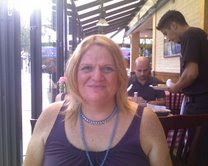The other day I commemorated the tenth anniversary of Gwen Araujo's brutal murder.
During the four years I've kept this blog, I've also written about the murders of Amanda Gonzalez-Andujar, Rita Hester, Coko Williams and Thapelo Makutle.
Apart from the fact that they were transgender women and the sheer brutality of their killings, what else did they have in common?
You might have guessed: They are all women of color, nonwhite, or whichever term you want to use.
Reports from Interpol and other investigative agencies show that no one runs a higher risk of being a homicide victim than a transgender person. And, in the United States at any rate, people account for a disproportionate number of the corpses in the county morgue.
I was reminded of these facts by an excellent article someone passed on to me. In it, Kimberly McLeod reports that, according to the National Coalition of Anti-Violence programs, violence against LGBT people rose 23 percent from 2009 to 2010, with people of color and transgender women being the most common victims. Of the LGBT people who were murdered in 2010, 70 percent were people of color and 44 percent were transgender women.
As it happens, the murders of people of color and transgenders are also the least likely to culminate with the arrest and conviction of the person(s) responsible. In many instances, no more than a perfunctory investigation is done, if any is done at all.
What further exacerbates the dangers and inequities faced by trans people of color is that many trans people are, essentially, alone in this world: Their friends, families, communities and employers have cut ties with them, or they had to leave those people and places to escape harassment and in the hope of escaping violence. And, of course, killings of people of color are simply not a high priority in many police forces and communities.
During the four years I've kept this blog, I've also written about the murders of Amanda Gonzalez-Andujar, Rita Hester, Coko Williams and Thapelo Makutle.
Apart from the fact that they were transgender women and the sheer brutality of their killings, what else did they have in common?
You might have guessed: They are all women of color, nonwhite, or whichever term you want to use.
Reports from Interpol and other investigative agencies show that no one runs a higher risk of being a homicide victim than a transgender person. And, in the United States at any rate, people account for a disproportionate number of the corpses in the county morgue.
I was reminded of these facts by an excellent article someone passed on to me. In it, Kimberly McLeod reports that, according to the National Coalition of Anti-Violence programs, violence against LGBT people rose 23 percent from 2009 to 2010, with people of color and transgender women being the most common victims. Of the LGBT people who were murdered in 2010, 70 percent were people of color and 44 percent were transgender women.
As it happens, the murders of people of color and transgenders are also the least likely to culminate with the arrest and conviction of the person(s) responsible. In many instances, no more than a perfunctory investigation is done, if any is done at all.
What further exacerbates the dangers and inequities faced by trans people of color is that many trans people are, essentially, alone in this world: Their friends, families, communities and employers have cut ties with them, or they had to leave those people and places to escape harassment and in the hope of escaping violence. And, of course, killings of people of color are simply not a high priority in many police forces and communities.










No comments:
Post a Comment